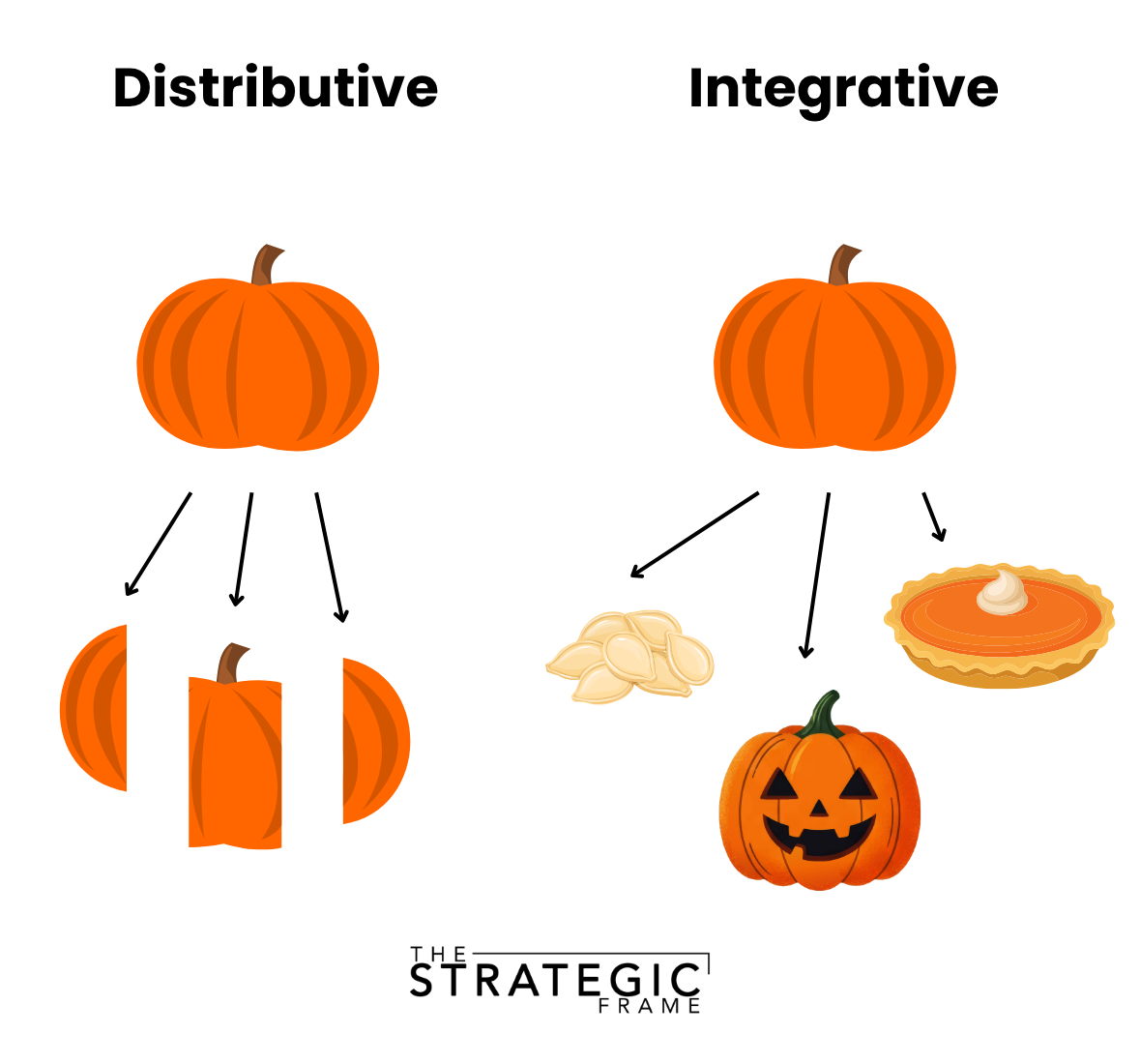Integrative Negotiations
Find Better Outcomes Through Collaboration
EXECUTIVE SUMMARY:
Negotiations often default to a distributive mindset, where one side’s gain is the other’s loss. This zero-sum approach can overlook opportunities to create better outcomes. Integrative negotiations take a different path by uncovering the underlying interests of each party and finding ways to meet those interests simultaneously.
In practice, integrative solutions are more common than we assume. By asking the right questions and exploring what truly matters to each side, many seemingly fixed conflicts can be resolved in ways that benefit everyone involved.
Say you are at a store on an October afternoon and there is only one pumpkin left. You and two others reach for it at the same time and find yourselves in a standoff. If you get the pumpkin, no one else will. If someone else gets it, you will not. Your plan to carve a jack-o-lantern with your child seems at risk of being quashed.
Do you flip a coin or play rock-paper-scissors and leave the decision to chance? Or agree that no one buys it, so everyone walks away empty-handed?
Someone suggests a compromise: one person buys the pumpkin, then cuts it into thirds. But that doesn’t really solve the problem. You can’t carve a face into just a third of a pumpkin.
Then you have an idea. You decide to ask a question to the group: “Why do each of you want the pumpkin?”
Everyone responds. It turns out your interest is the shell for carving a jack-o-lantern. The second person wants the seeds to roast for a snack. The third wants the flesh to make a pie.
You strike a deal. One of you buys the pumpkin, you split the cost three ways, and each person walks away with exactly what they wanted, all while saving money.
Everyone wins.
Distributive vs. Integrative Negotiations
There are two broad approaches to negotiation: distributive and integrative.
A distributive negotiation assumes there is a fixed pumpkin to divide. Whatever one side gains, the other side loses. This approach often shows up in price haggling, salary discussions, or one-off transactions. The focus is on claiming value, not creating it. Each side typically starts with extreme positions, makes concessions, and eventually meets somewhere in the middle. The relationship often feels competitive, and trust can be hard to build because each concession feels like a loss.
An integrative negotiation takes a different mindset. Instead of assuming resources are limited, both sides explore the underlying reasons behind their positions to uncover shared interests. By doing so, they can often identify new options that expand the total value available. In this approach, success is defined not by how much one side “wins” but by how much both sides benefit.
In business, distributive negotiations might look like a supplier and buyer arguing over a unit price without considering other factors. The conversation revolves around who gets a larger share of the existing margin. An integrative negotiation might focus on reducing costs through more efficient delivery schedules, improving quality to reduce returns, or offering longer-term contracts that create stability for both parties. These solutions create additional value that did not exist when the focus was only on price.
Integrative negotiations are particularly powerful when the parties expect to work together over time. Building trust and finding mutual gains strengthen the relationship and make future negotiations easier. Distributive tactics may secure a quick win today, but can damage relationships or leave opportunities undiscovered.
Tips to Achieve Integrative Negotiations
I was first introduced to the concept of integrative negotiations in my Negotiation course at Harvard University. What stood out to me was that only about ten percent of the curriculum focused on distributive tactics. The rest emphasized finding mutual gains. The message was striking to me: more often than we think, integrative solutions are within reach if we approach negotiations with curiosity, empathy, and creativity.
Here are some practical tips for putting integrative negotiation principles into action:
Focus on interests, not positions: Ask why each side wants what they want to uncover motivations that lead to creative solutions.
Ask open-ended questions: Use thoughtful questions to reveal hidden priorities, constraints, and opportunities to expand the pie.
Brainstorm options first: Generate several possible solutions before deciding, to avoid settling too early on a narrow choice.
Trade on differences: Identify what each side values most and make trade-offs that maximize joint gains.
Use objective standards: Anchor agreements to market data or expert benchmarks to build fairness and trust.
Wrapping It All Up
Many negotiations feel like a zero-sum contest, but real opportunities often emerge once you understand what each side truly needs. The pumpkin story shows that by uncovering those interests, you can reach solutions that meet everyone’s goals more effectively.
Is there a negotiation you are in right now, or one coming up soon, where asking a few more questions could reveal a better path forward? Approaching it with curiosity and collaboration might unlock value you did not realize was there.
This email is sponsored by Let’s Go Design Co.
Let’s Go Design Co. helps business and property owners tell powerful stories through brand-driven design. From bold murals to strategic interiors, they create scroll-stopping spaces and visuals that move the needle. Learn more at https://www.letsgodesign.co/.



